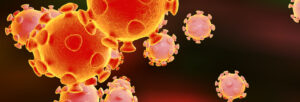The World Health Organization (WHO) announced on Wednesday, March 11 that coronavirus, officially known as COVID-19, has reached pandemic level.

As the number of reported cases of coronavirus increase globally, misinformation, speculation, and fear continue to spread on social media. Being informed is the first line of defense in protecting your family.
What is COVID-19
WHO designated the name COVID-19 for this particular coronavirus that is currently impacting the world. The seemly odd name does have significance; “co” for corona, “vi” for virus and “d” for disease — and because the outbreak began in 2019.
Symptoms include fever, cough, and shortness of breath. Diagnosis can be difficult since symptoms are similar to the flu or a cold. At this time, only a lab test can confirm the presence of COVID-19.
John Hopkins Medicine explains that multiple coronaviruses are in existence, each with their risks. Severe acute respiratory syndrome (SARS) and Middle East respiratory syndrome (MERS) are two other well-known coronaviruses. The name “corona” is applied to viruses that appear to be covered with pointed structures resembling a crown when viewed under a microscope.
Transmission and Incubation
Based on current evidence, the Center of Disease Control CDC states that COVID-19 is spread person-to-person by respiratory droplets caused from coughing or sneezing. It is possible to that COVID-19 can be spread by touching contaminated surfaces, but the life expectancy of the virus on a surface is yet to be determined.Some people exhibit symptoms of coronavirus within a day of exposure and others don’t show symptoms for 2 weeks.Analysis completed by Johns Hopkins Bloomberg School of Public Health states that on average, people will show symptoms of COVID-19 5.1 days after exposure. The CDC currently suggests a 14-day quarantine for exposed persons. This quarantine period is based on evidence that 97.5% people who will develop symptoms do so within 11.5 days of exposure.
How to Protect Yourself
The CDC and Georgia Department of Health suggest following similar measures to avoid COVID-19 as you would to avoid the flu.
- Wash your hands for at least 20 seconds
- Avoid touching your eyes, nose, or mouth
- Keep of distance of 6-feet from sick or potentially sick people
- Stay home if you are sick
- Cough into your elbow and sneeze into tissue. Immediately dispose of used tissues and wash your hands.
- Clean and disinfect door handles, counters, and frequently touched surfaces in your home
Wearing a facemask is NOT advised to prevent COVID-19.
The greatest difference between the flu and COVID-19 is that many Americans are vaccinated against or immune to the flu, yet COVID-19 is new and our bodies have no immunity.
Seeking Medical Advice
The CDC advises that the majority of affected people can recover at home in isolation. Isolation means spending time in a separate room from your family and pets and not sharing a bathroom (when possible). If you think you have been exposed to the coronavirus and are experiencing worsening symptoms (excessive fever or difficulty breathing), CALL your healthcare provider prior to seeking medical attention. Medical clinics and hospitals throughout Georgia and the nation are following protocols established by the CDC. Patients may be screened prior to entering a medical facility and those exhibiting symptoms of coronavirus will likely be separated from other waiting patients.
Continue to monitor information provided by the CDC and Georgia Department of Health for updates regarding COVID-19. As spring break approaches, it is vital to review the travel advisories and recommendations.
Social media may be quick, but it likely isn’t sharing the factual information you need to stay safe.
